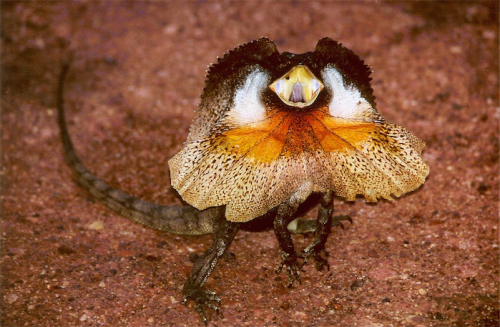
Frill neck lizard. Photo by Miklos Schiberna
The research solves a mystery of how the lizards get their colours. Most previous studies have focused on the role of colouration in lizards. The colour of the frill varies from red, orange, yellow and white.
“We found that individuals with a red or orange frill found in western populations in the Kimberley and Top End had more colour pigments in their frill than lizards with a yellow or white frill found in Queensland,” said lead author Dr Thomas Merkling from the ANU Research School of Biology.
He said the colour differences were due to variations in concentrations of two types of pigments. The lizards obtain one pigment from their food and can synthesise the other directly in their cells.
The lizards with red or orange frills had much more dietary pigments in their frill and in their blood than the others, suggesting their prey contained more pigments. The pigments that lizards can synthesise were absent in those with a yellow or white frill.
Dr Merkling said that to better understand the role of animal colouration it was also important to know how colour is produced.
“Different kind of pigments can produce similar colours and these pigments have different ways of being acquired by animals. For instance, colours produced by a limitless pigment probably don’t have the same role as those produced by a rare and limited pigment,” he said.
“Given the differences in pigmentation among frill neck lizard populations, it is tempting to suggest that frill colour may have a different role in the different populations.”
Dr Merkling said that a better understanding of how colours are produced will help researchers to uncover the diversity of functions of animal colouration.
The research was published in the Biological Journal of the Linnean Society.
The post Colourful end to lizard mystery appeared first on Canberra CityNews.